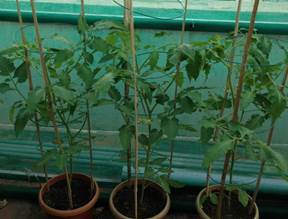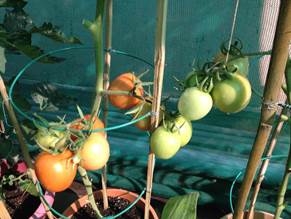How to grow Tomato?
Tomato Overview
Growing your own tomatoes can’t get simpler. For, planting a few plants will reward you with plenty of sweet-tasting tomatoes in the summer. There are all kinds of tomatoes to try, such as, the tiniest cherry types that the kids love to the full-flavored giant beefsteak tomatoes. And not to confuse tomatoes and the color red. For, they come in all kinds of colors too - green and orange, even purple tomatoes or striped tomatoes.
This document focuses on growing Regular Tomatoes.
Table 1 Planting Guide
|
Depth to plant |
0.25 inches deep |
|
Spacing between seeds |
Space plants about 2' - 3' apart |
|
Spacing between seedlings |
Space rows about 4' apart |
|
Days to germinate (Sprout) |
7 - 14 days |
|
Planting season |
Summer |
|
Plant height |
Variable |
|
No. of Plants per sq. ft. |
1 or 2 plant per sq. ft. |
|
Soil requirement |
Prefers soil with pH levels of 5.5 - 6.5. |
Tomato Prerequisites
- Plant Type: Perennial grown as an annual plant.
- Light: Full Sun
- Water: When it comes to watering tomatoes in container gardens, keep the potting soil constantly moist
Tomato Growing Steps
The following steps define the process from seed to harvest.
1. You must sow the heirloom seeds of regular tomatoes from My Green Vault in pro trays and then transplant. For more information on sowing seeds and germination tips, refer to ***.
2. Prepare your tomatoes for transplanting once the plants have reached at least 1/2-foot in height.

3. Prepare a good growing medium. A good, simple option is a mix of two parts potting soil, one part Coco Peat (CP) and one part Vermi Compost (VC). The soil and VC provides your plant with the nutrients it needs, while the CP mix retains the moisture.

4. Place your pot in a sunny location and ensure to provide adequate support system or staking.

NOTE: Without any staking, your tomatoes will have very little upward growth and, as a result, they will yield very little fruit. Do you wish to know about tomato varieties? Click “Tomato varieties“ on page 6.
Tomato Varieties
While you check the tomato varieties, you must mainly focus on those with resistance to soil-borne pests. Resistance is determined for verticillium, fusarium, and nematodes. It may be that your soil is not infested with any of these pests, however, if you've had any trouble with tomatoes in the past, favor the resistant varieties.
The growth habit of the variety is indicated by "determinate" or "indeterminate." Determinate varieties are the bush kinds, generally growing to 3 feet or less. Indeterminate are tall-growing and are trained with stakes, trellis or wire cage.
Tomato and Suckers
The big question! To sucker or not to sucker. Whether to remove the side shoots that grow out of the leaf axiles or not depends on the support system used. Generally, it is advisable to snap off these side shoots. If tomatoes are grown in cages the suckers are generally left on, although it's a good idea to pinch the tip out of them when they are 6-8 inches long. Wait until the plants are knee-high and, in the morning when the plants are nice and turgid, snap off the lower growth.
Tomato Plant Maintenance
Tomatoes require evenly moist soil to ensure the best and fast growth. Do not over water or allow the soil to dry out. Should you prune out tomato suckers (side shoots) or not? Click “Tomatoes and suckers“ on page 6, to know more.
1. Tomatoes are heavy feeders. When your tomatoes bloom, to help promote greater plant productivity, add adequate amount of VC or Compost Tea (CT).

Note: For more information on CT preparation and application, refer to ***.
2. Make sure your tomatoes receive at least 1“-1 1/2” of water a week.

3. Once the soil has warmed, mulch around tomatoes to retain soil moisture and an even growing temperature.
Tomato Companion Plants
Amaranth, basil, bean, carrots, celery, cosmos, cucumber, garlic, marigolds.
Tomato Plant Protection
Tomato Pests
Tomatoes can be attacked by the following:
- White flies
- Spider mites and Aphids
Tomato Diseases
- Damping off and Nematode
- Leaf spot
- Leaf curl
- Tomato spotted wilt virus
- Tomato blight
Tomato Other problems
- Poor fruit color
- Blossom end rot
- Failure to set fruit/Blossom drop
Tomato Organic Control
Once you have identified the troublemakers, you can control them with an assortment of organic pest-control methods. The following list contains few methods:
a. White flies
– Monitor the whitefly with yellow sticky trap
– Spray Neem oil
Note: For more information on neem oil dilution and application, refer to ***. b.
b. Leaf curl
– Ensure even watering on a regular basis and careful pruning
– Limit excessive water
– Reduce too much of Nitrogen
c. Tomato blight
– Baking-soda spray, which consists of 1 tsp of baking soda mixed with 2 1/2 tsp of vegetable oil. Once you have thoroughly mixed the baking soda with the oil, add 1 liter of water, 1/2 tsp of liquid soap, and 2 tsp of baking soda mix.
– Mulch added around the plants will protect roots while preventing fungal infection
d. Damping off and Nematode
– Treat the seeds with Trichoderma viride or Pseudomonas fluorescens 24 hours before sowing
– Apply Pseudomonas fluorescens as soil application
– Avoid water stagnation
e. Spider mites and Aphids
– Spray home made garlic and insecticidal soap solution
Note: For more information on preparation and application of garlic and insecticidal soap spray, refer to ***.
f. Leaf spot
– Remove the affected plants in the early stages to control the vector
g. Tomato spotted wilt virus
– Remove and destroy the plants or other affected garden plants
– Keep a tab on weeds in and around the plants
h. Blossom end rot
– Symptoms of this disease appear as a leathery scar or rot on the blossom-end of fruits. It can occur at any stage of development and is usually caused by sudden changes in soil moisture, most serious when fast-growing plants are hit by a hot, dry spell.
Mulching, which reduces fluctuations in soil moisture and temperature, and avoiding planting in poorly drained soil, will help prevent blossom-end rot
– Lack of calcium is another cause. Add a pinch of chuna (lime) mixed in 1 liter of water
i. Failure to set fruit/Blossom drop
– Failure for the pollen to germinate and slow tube growth results in blossoms to drop off before they can be fertilized. Fruit set can be increased by shaking the plant, or vibrating it, to release pollen for pollination. When plants are trained on stakes, hitting the top of the stakes will have the same effect
j. Poor fruit color
– Where high temperatures are the rule, choose varieties with a dense foliage cover
Tomato Harvesting
Your organic tomatoes are ready for harvest when they begin to show color.

The time from planting to harvest is 60 to 85 days from transplants. Finally, the hard work pays off and you have red beauties!

